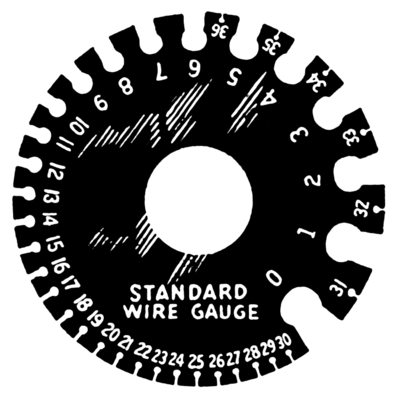Wire gauge

Wire gauge measures a wire's cross sectional area. Knowing the gauge is important because it determines how much electric current a wire can carry without being damaged—this quantity is called ampacity.
American Wire Gauge System
The American Wire Gauge system or AWG standardizes the cross sectional area of a wires by assigning them an AWG number. As seen in Figure 1, a lower numbered gauge wire has a larger diameter and thus is able to carry higher currents. There are a total of 40 different gauge sizes with cross sectional areas ranging from 0.013 mm2 to 107.22 mm2 with their diameters changing incrementally between each gauge number.
Wire Gauge Values
The figures in the table below are taken from Table 310.15(B)(16) in the 2014 National Electrical Code (USA) and assume a temperature rating of 90°C.[2] Also, Table 3.1 on page 69 in Introduction to Electricity was used as a template and reference.[3]
| AWG number | Cross sectional area (mm2) | Ohms/km (/km) | Ampacity (A) | Usage example |
|---|---|---|---|---|
| 18 | 0.82 | 20.95 | 14 | Low voltage lighting |
| 16 | 1.31 | 13.18 | 18 | Extension cords |
| 14 | 2.08 | 8.28 | 25 | Lighting fixtures |
| 12 | 3.31 | 5.21 | 30 | Kitchen appliances |
| 10 | 5.26 | 3.28 | 40 | Electric dryers |
| 8 | 8.37 | 2.06 | 55 | Electric ovens |
| 6 | 13.30 | 1.30 | 75 | Large electric heaters |
| 4 | 21.15 | 0.81 | 85 | Large furnaces |
| 3 | 26.67 | 0.65 | 115 | Large commercial wiring |
| 2 | 33.63 | 0.51 | 130 | Car battery cable |
| 1 | 42.41 | 0.41 | 145 | Power distribution |
| 1/0 | 53.47 | 0.32 | 170 | Power distribution |
| 2/0 | 67.43 | 0.26 | 195 | Power distribution |
| 3/0 | 85.03 | 0.20 | 225 | Power distribution |
| 4/0 | 107.22 | 0.16 | 260 | Power distribution |
| 250 | 126.68 | 0.13 | 290 | Power distribution |
| 350 | 177.35 | 0.10 | 350 | Power distribution |
| 400 | 202.68 | 0.08 | 380 | Power distribution |
For a more complete list, please see Dr. Rowlett's unit page.
For Further Reading
For further information please see the related pages below:
- Wire
- Direct current
- Alternating current
- Electrical grid
- Or explore a random page!
References
- ↑ Wikimedia Commons. (October 3, 2015). Wire Gauge [Online]. Available: https://upload.wikimedia.org/wikipedia/commons/2/23/Wire_gauge_(PSF).png
- ↑ "2014 National Electrical Code" Table 310.15(B)(16)
- ↑ R. Paynter and B. Boydell, Introduction to electricity. Upper Saddle River, N.J.: Pearson Prentice Hall, 2011.

